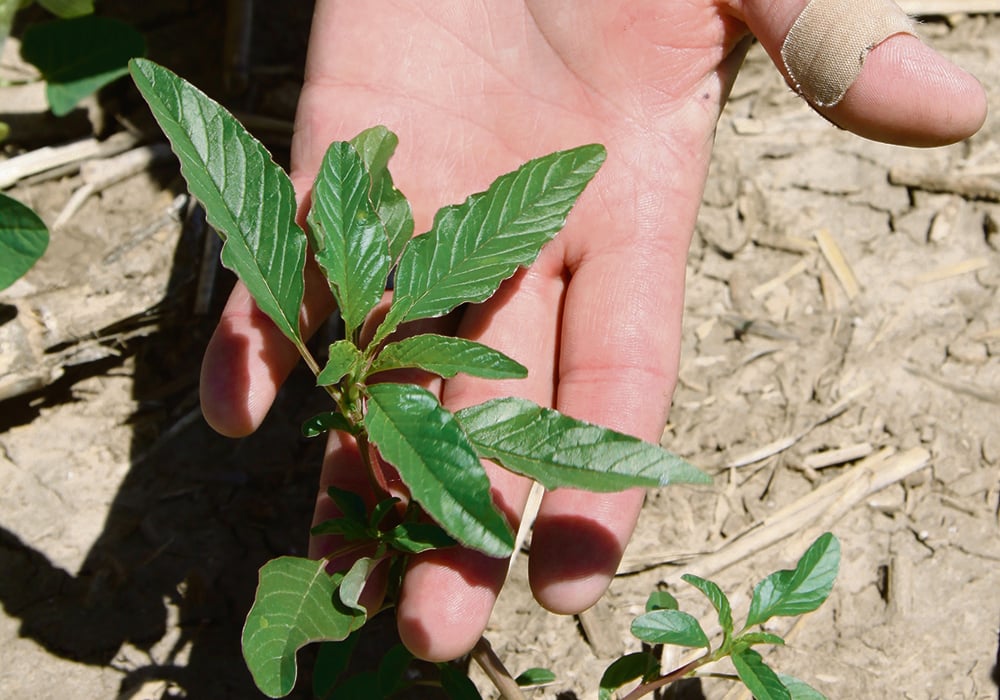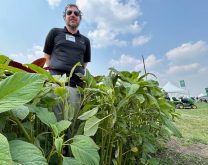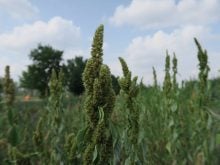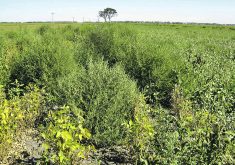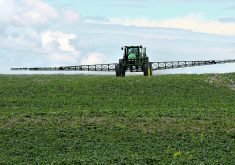Genetic mutations make it possible for the weed to rapidly adapt to agricultural conditions and environmental changes
The common waterhemp, a plant native to the United States, has become a hard-to-control invasive weed on farmland in Canada too.
A single plant can grow 2.5 centimetres a day and, in a growing season, each single plant can produce up to 4.8 million seeds.
Recent research by scientists at the University of British Columbia and the University of Toronto has shown how the plant’s genetic mutations allow for its success. It has the ability to rapidly adapt to agricultural conditions and environmental changes, spreads at an alarming rate, and is resistant to a variety of herbicides.
Read Also

Fertilizer method’s link to emissions studied
A researcher says others studying greenhouse gas emissions aren’t considering how the loss of nitrogen into the atmosphere correlates with fertilizer application or if there is an impact to yield.
“In recent decades, waterhemp has distinguished itself as one of the most problematic agricultural weeds in the midwestern United States,” said Dr. Julia Kreiner, postdoctoral researcher in the department of botany at UBC.
“It competes heavily with corn and soy, drawing down crop yields. On top of that, it has become extremely difficult to control due to widespread cross-resistance to multiple modes of herbicides. And the problem does not appear to be contained. Within the last decade, waterhemp has been spreading and invading agricultural fields in Canada.”
According to a news release, the research team compared 187 waterhemp samples from working farms and neighbouring wetlands with more than 100 historical samples dating back to1820 and stored in museums across North America. By studying the plant’s genetic make-up over two centuries, they could see evolution in action across changing environments.
“We were surprised to see just how quickly modern agricultural practices have reshaped the genetic composition of waterhemp populations across the range,” said Kreiner. “Variants of hundreds of genes that give waterhemp an advantage on farms have dramatically increased in frequency since the rise of industrial agriculture in the 1950s. This is much faster than rates of evolution that typically occur in the wild, a process thought to play out over thousands and millions of years.”
The research team focused on information gained from preserved plant collections. Kreiner said that observing the genetic changes in waterhemp would not have been possible without the historic plants having been deposited into museums by community scientists and botanists.
The researchers discovered hundreds of genes across the weed’s genome that aid its success on farm fields with mutations in genes relating to drought tolerance, rapid growth and herbicide resistance appearing frequently.
“The genetic variants that help the plant do well in modern agricultural settings have risen to high frequencies remarkably quickly since agricultural intensification in the 1960s,” she said.
Essentially, agriculture drove genome-wide diversity, allowing for the huge success of this weed. The advances of modern farming have unwittingly provided a launchpad for waterhemp to accelerate its own adaptations and take advantage of farmland.
“These results highlight the enormous potential of studying historical genomes to understand plant adaptation on short timescales,” said Stephen Wright, co-author and professor in Ecology and Evolutionary Biology at the University of Toronto. “Expanding this research across scales and species will broaden our understanding of how farming and climate change are driving rapid plant evolution.”
Despite waterhemp’s invasion of farmland, it is still prevalent in natural areas such as wet, marginal habitats alongside rivers and streams as well as marshes.
Wet regions can be environmentally disturbed not necessarily by humans but by rising and shifting water levels. Kreiner suggested that since waterhemp has survived in these disturbed areas for so long, the variable habitats may have predisposed the species to an adaptability to thrive in disturbed agricultural land.
“One big difference that remains between natural and agricultural settings is water availability,” she said. “Our work suggests that one important shift waterhemp has had to make in its transition to agricultural environments is drought tolerance.”
Recognizing early emergence of spreading waterhemp populations is essential to getting ahead of it.
“Letting us know when populations are suddenly going uncontrolled by their typical herbicide applications is the first clue that a new variant of resistance may have arisen and is a priority for regional control efforts.”
The research on the historical plant samples compared to contemporary samples showed that five out of seven herbicide-resistant mutations found in current samples were absent from the historical ones. Waterhemp carrying any of the seven herbicide-resistant mutations has produced an average of 1.2 times as many surviving offspring per year since 1960 compared to plants that don’t have the mutations.
“Modern farms impose a strong filter determining which plant species and mutations can persist through time,” said Kreiner. “Sequencing the plants’ genes, herbicides stood out as one of the strongest agricultural filters determining which plants survive and which die.”
She added GMO technology has streamlined the process by producing crops resistant to herbicides and farmers often use herbicides throughout the growing season to control weeds that constantly emerge. This approach has worked well until now, but with robust waterhemp resistance arising and spreading to thwart almost every chemical mode of herbicide developed, it is imperative that researchers learn why and how quickly these plants can adapt to herbicide use.
Herbicide resistant mutations were also discovered in natural habitats but at a lower frequency.
“In the absence of herbicide applications, being resistant can actually be costly to a plant, so the changes happening on farms are impacting the fitness of the plant in the wild,” said Kreiner.
Going forward, the research will focus on how quickly different agricultural practices shape weed evolution across growing seasons and how that shapes plant evolution across the landscape. The team will explore how crop field proximity to nearby natural habitat influences how rapidly these plants are evolving (becoming weedier), and how much crop rotation strategies can slow the progression of plants toward becoming problematic weeds.
The research was published in the journal Science.



